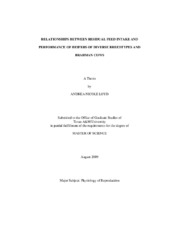| dc.description.abstract | These studies were designed to evaluate the relationships between residual feed
intake (RFI) and performance of growing heifers and Brahman cows. Residual feed
intake was determined for 77 heifers of diverse breedtypes (Angus, Brahman, Hereford,
Holstein, Jersey and F1 crosses) during both the pre- and post-pubertal periods. Heifers
were individually fed and allowed ad libitum access to feed for 84 +/- 6 d during the prepubertal
feeding trial and 90 +/- 4 d during the post-pubertal feeding trial. Brahmaninfluenced
heifers had lower RFI than heifers without Brahman influence during both
the pre-pubertal (P < 0.05) and post-pubertal (P < 0.0001) periods. Residual feed intake
determined during the pre-pubertal period was only a moderate predictor (r = 0.48; P <
0.0001) of RFI determined during the post-pubertal period.
Residual feed intake was determined for 38 Bonsmara heifers over a 70-d
feeding period. Heifers were fed a high roughage diet at 2.65% of body weight (BW).
Weekly blood serum samples were analyzed for progesterone concentration by
radioimmunoassay (RIA) to determine puberty. There were no observed differences between efficient and inefficient heifers for performance traits, age at puberty or
conception, or cumulative achievement of puberty and conception.
The postpartum performance of Brahman primiparous (n=16) and multiparous
(n=38) cows previously evaluated postweaning for RFI was investigated. Females were
weighed and evaluated for body condition score (BCS) at 28-d intervals prior to the start
of the 2008 calving season. Weekly weights and BCS were collected beginning 21 d
after calving. Blood serum samples were also collected weekly for progesterone
analysis by radioimmunoassay (RIA), non-esterified fatty acid (NEFA) analysis by
enzymatic colorimetry, and insulin-like growth factor-I (IGF-I) analysis by RIA.
Females were exposed to vasectomized marker bulls after calving to aid in estrus
detection. Eight and ten d following observed estrus, females were evaluated using
ultrasonography via rectal palpation to determine the presence of a corpus luteum (CL).
Efficient cows exhibited estrus, developed functional corpora lutea, and exhibited estrus
with CL formation earlier (P < 0.05) than inefficient cows. Furthermore, a greater
percentage (P < 0.05) of efficient than inefficient cows were pregnant at the end of the
breeding season. | en |


